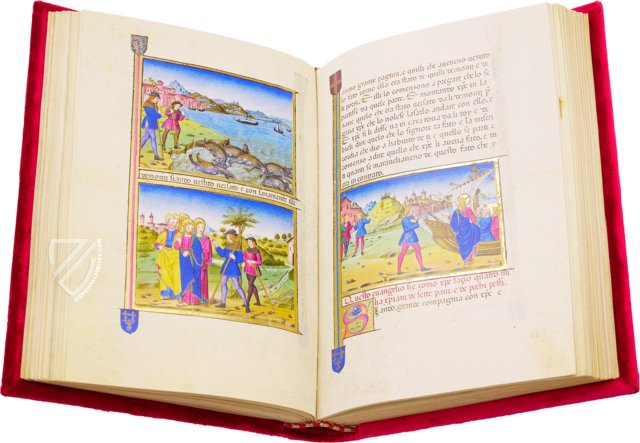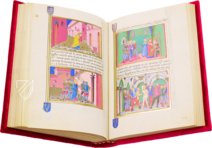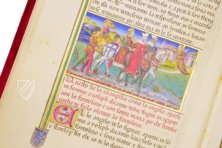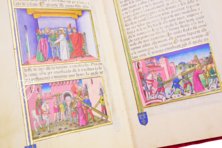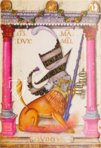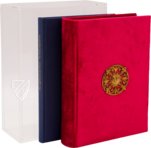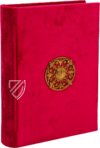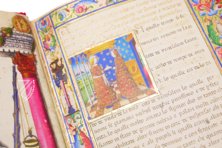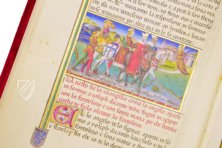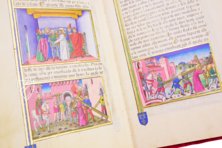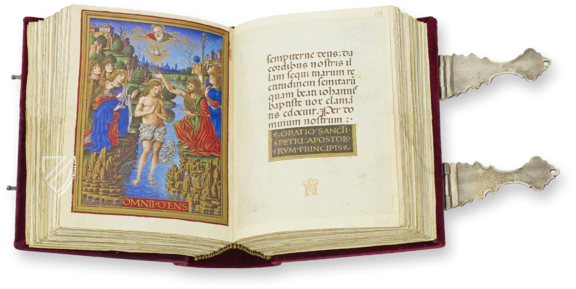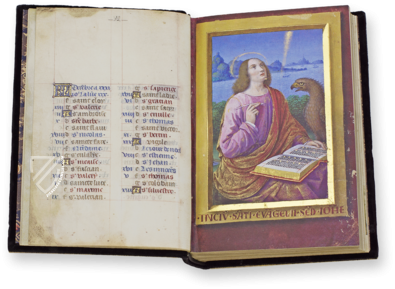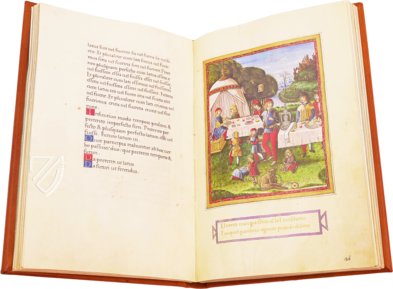Sforza Legendarium
(3,000€ - 7,000€)
The Duke of Milan, Galeazzo Maria Sforza is famous as a great patron of music and the arts. In 1476, the famous Milanese illuminator Cristoforo de Predis created one of the most beautiful manuscripts of the Italian Renaissance with the opulently furnished Sforza Legendarium. The private devotional book illustrates the histories and legends of the Virgin Mary, John the Baptist, the Son of God, and closes with the Last Judgement. The 324 miniatures altogether distinguish themselves through their impressive combination of lush, luminous colors, and shimmering gold filigree. Thanks to his exceptional powers of observation, the deaf-mute artist allowed small details from contemporary life to flow into the harmonious compositions.
Sforza Legendarium
As the Duke of Milan, Geleazzo Sforza was famous as a great patron of music and the arts. As such, the famous illuminator Cristoforo de Predis created one of the most beautiful manuscripts of the Italian Renaissance for him in 1476, the opulently furnished Sforza Legendarium. As a book for private devotion and meditation, the legendarium illustrated the histories and legends of the Virgin Mary’s parents, as well as her childhood up the Annunciation. Following seamlessly is the tale of the life, miracles, and Passion of Christ up to the events of the Pentecost. The life of John the Baptist is similarly portrayed. The richly illustrated volume closes out with masterful miniatures of the Last Judgement.
An Exceptional Diversity of Images
Boasting 324 miniatures altogether, the legendarium impresses its beholder. Each individual depiction shines in a metallic gloss in combination with an astounding palette of intensely luminous colors. The variety of scenes from the salvation history of the New Testament is also unmatched. The North Italian inspiration is obvious in everything from individual architectural elements to entire edifices to fashion. Galeazzo was intended to recognize his own Duchy as the backdrop of the biblical scenes. The combination of powerful colors, which are finely nuanced, and shimmering filigrees of gold lend an exceptional liveliness to the illustrations. In doing so, the creations remain in a harmonious balance between concrete reality and imaginary space, between the holy and the profane, as well as the aristocratic and the folksy.
A Deaf-and-Dumb Painter with Special Observation Skills
The Milanese miniaturist Cristoforo de Predis was born deaf-and-dumb and was already a highly esteemed miniaturist at the Sforza court since 1471. His painting is distinguished by its many small details from contemporary life and an exceptionally intuitive gesticulation of the figures. He was always carefully observant with a curious attentiveness to reality: the city surrounding him, the everyday life and emotions of his fellow human beings. Resulting therefrom are the gentle countryside of the Po Valley, wide horizons, thronged streets and Piazzas, but also elegant dining halls and simple chambers. Numerous building materials used at that time such as bricks, stone, marble, colored plaster, and wood were taken into account, and he also dealt intensely with lighting effects in interior spaces. There are even traces of the recently invented central perspective to be found in his compositions.
Codicology
- Alternative Titles
- Sforza-Savoia-Legendarium
Légendier des Sforza
Codice Varia 124 della Biblioteca Reale di Torino
Legendarium der Sforza
Leggendario Sforza-Savoia - Size / Format
- 316 pages / 26.4 × 18.2 cm
- Origin
- Italy
- Date
- 1476
- Epochs
- Style
- Genre
- Language
- Illustrations
- 324 miniatures of various size and 107 golden initials
- Content
- Legends from the New Testament beginning with the parents of the Virgin Mary through the life of Christ up until Pentecost
- Patron
- Galeazzo Maria Sforza, Duke of Milan (1444–1476)
- Artist / School
- Cristoforo de Predis
- Previous Owners
- Galeazzo Maria Sforza
Sforza Legendarium
Portrait of the Duke and Duchess of Milan
Standing in an arcade painted sky blue and adorned with stars, Galeazzo Maria Sforza is depicted hand-in-hand with his wife, who must be Bona of Savoy because his first wife, Dorotea Gonzaga, died three years before the manuscript was created. They are both dressed in flowing red robes embellished with cloth of gold and each of their heads is surrounded by a ray nimbus. The towers of a walled city, probably intended to be Milan, can be seen in the distance.

Sforza Legendarium
Heraldic Symbols of Galeazzo Maria Sforza
For the first page of the manuscript, Cristoforo de Predis created a full-page miniature of the heraldic symbols of Galeazzo Maria Sforza that was very much in keeping with the Duke’s luxurious artistic taste. Like the other 323 miniatures in the work, it was created using bright, powerful colors and shimmering gold leaf.
Seated in flames and sparks, a lion wearing the enclosed steel helmet of a knight holds a blue stick from which two golden buckets are swinging. The heraldic symbols are presented in a classical architecture with pink marble columns and Corinthian capitals that support an entablature with varying rows of patterns as well as garlands with fruits that are suspended from golden discs or plates.

#1 Leggendario Sforza-Savoia
Language: Italian
(3,000€ - 7,000€)
#2 Das Legendarium der Sforza
Languages: English, German
(3,000€ - 7,000€)
- Treatises / Secular Books
- Apocalypses / Beatus
- Astronomy / Astrology
- Bestiaries
- Bibles / Gospels
- Chronicles / History / Law
- Geography / Maps
- Saints' Lives
- Islam / Oriental
- Judaism / Hebrew
- Single Leaf Collections
- Leonardo da Vinci
- Literature / Poetry
- Liturgical Manuscripts
- Medicine / Botany / Alchemy
- Music
- Mythology / Prophecies
- Psalters
- Other Religious Books
- Games / Hunting
- Private Devotion Books
- Other Genres
- Afghanistan
- Armenia
- Austria
- Belgium
- Colombia
- Croatia
- Cyprus
- Czech Republic
- Denmark
- Egypt
- Ethiopia
- France
- Germany
- Greece
- Hungary
- India
- Iran
- Iraq
- Israel
- Italy
- Japan
- Lebanon
- Luxembourg
- Mexico
- Morocco
- Netherlands
- Palestine
- Peru
- Poland
- Portugal
- Russia
- Serbia
- Spain
- Sri Lanka
- Sweden
- Switzerland
- Syria
- Turkey
- Ukraine
- United Kingdom
- United States
- Uzbekistan
- Aboca Museum
- Ajuntament de Valencia
- Akademie Verlag
- Akademische Druck- u. Verlagsanstalt (ADEVA)
- Aldo Ausilio Editore - Bottega d’Erasmo
- Alecto Historical Editions
- Alkuin Verlag
- Almqvist & Wiksell
- Amilcare Pizzi
- Andreas & Andreas Verlagsbuchhandlung
- Archa 90
- Archiv Verlag
- Archivi Edizioni
- Arnold Verlag
- ARS
- Ars Magna
- ArtCodex
- AyN Ediciones
- Azimuth Editions
- Badenia Verlag
- Bärenreiter-Verlag
- Belser Verlag
- Belser Verlag / WK Wertkontor
- Benziger Verlag
- Bernardinum Wydawnictwo
- BiblioGemma
- Biblioteca Apostolica Vaticana (Vaticanstadt, Vaticanstadt)
- Bibliotheca Palatina Faksimile Verlag
- Bibliotheca Rara
- Boydell & Brewer
- Bramante Edizioni
- Bredius Genootschap
- Brepols Publishers
- British Library
- C. Weckesser
- Caixa Catalunya
- Canesi
- CAPSA, Ars Scriptoria
- Caratzas Brothers, Publishers
- Carus Verlag
- Casamassima Libri
- Chavane Verlag
- Christian Brandstätter Verlag
- Circulo Cientifico
- Club Bibliófilo Versol
- Club du Livre
- CM Editores
- Collegium Graphicum
- Collezione Apocrifa Da Vinci
- Comissão Nacional para as Comemorações dos Descobrimentos Portugueses
- Coron Verlag
- Corvina
- CTHS
- D. S. Brewer
- Damon
- De Agostini/UTET
- De Nederlandsche Boekhandel
- De Schutter
- Deuschle & Stemmle
- Deutscher Verlag für Kunstwissenschaft
- DIAMM
- Droz
- E. Schreiber Graphische Kunstanstalten
- Ediciones Boreal
- Ediciones Grial
- Ediclube
- Edições Inapa
- Edilan
- Editalia
- Edition Deuschle
- Edition Georg Popp
- Edition Leipzig
- Edition Libri Illustri
- Editiones Reales Sitios S. L.
- Éditions de l'Oiseau Lyre
- Editions Medicina Rara
- Editorial Casariego
- Editorial Mintzoa
- Editrice Antenore
- Editrice Velar
- Edizioni Edison
- Egeria, S.L.
- Eikon Editores
- Electa
- Emery Walker Limited
- Enciclopèdia Catalana
- Eos-Verlag
- Ephesus Publishing
- Ernst Battenberg
- Eugrammia Press
- Extraordinary Editions
- Fackelverlag
- Facsimila Art & Edition
- Facsimile Editions Ltd.
- Facsimilia Art & Edition Ebert KG
- Faksimile Verlag
- Feuermann Verlag
- Folger Shakespeare Library
- Franco Cosimo Panini Editore
- Friedrich Wittig Verlag
- Fundación Hullera Vasco-Leonesa
- G. Braziller
- Gabriele Mazzotta Editore
- Gebr. Mann Verlag
- Gesellschaft für graphische Industrie
- Getty Research Institute
- Giovanni Domenico de Rossi
- Giunti Editore
- Graffiti
- Grafica European Center of Fine Arts
- Guido Pressler
- Guillermo Blazquez
- Gustav Kiepenheuer
- H. N. Abrams
- Harrassowitz
- Helikon
- Hendrickson Publishers
- Henning Oppermann
- Herder Verlag
- Hes & De Graaf Publishers
- Hoepli
- Holbein-Verlag
- Hortus Deliciarum
- Houghton Library
- Hugo Schmidt Verlag
- Idion Verlag
- Il Bulino, edizioni d'arte
- ILte
- Imago
- Insel Verlag
- Instituto Nacional de Antropología e Historia
- Istituto dell'Enciclopedia Italiana - Treccani
- Istituto Ellenico di Studi Bizantini e Postbizantini
- Istituto Geografico De Agostini
- Istituto Poligrafico e Zecca dello Stato
- Italarte Art Establishments
- J. Thorbecke
- Jan Thorbecke Verlag
- Johnson Reprint Corporation
- Josef Stocker
- Josef Stocker-Schmid
- Jugoslavija
- Karl W. Hiersemann
- Kasper Straube
- Kaydeda Ediciones
- Kindler Verlag / Coron Verlag
- Kodansha International Ltd.
- Konrad Kölbl Verlag
- Kurt Wolff Verlag
- La Liberia dello Stato
- La Linea Editrice
- La Meta Editore
- Lambert Schneider
- Landeskreditbank Baden-Württemberg
- Leo S. Olschki
- Les Incunables
- Library of Congress
- Libreria Musicale Italiana
- Lichtdruck
- Lito Immagine Editore
- Lumen Artis
- Lund Humphries
- M. Moleiro Editor
- Maison des Sciences de l'homme et de la société de Poitiers
- Manuscriptum
- Martinus Nijhoff
- Maruzen-Yushodo Co. Ltd.
- MASA
- McGraw-Hill
- Militos
- Millennium Liber
- Müller & Schindler
- Nahar and Steimatzky
- National Library of Wales
- Neri Pozza
- Nova Charta
- Oceanum Verlag
- Odeon
- Orbis Mediaevalis
- Orbis Pictus
- Österreichische Staatsdruckerei
- Oxford University Press
- Pageant Books
- Parzellers Buchverlag
- Patrimonio Ediciones
- Pattloch Verlag
- PIAF
- Pieper Verlag
- Plon-Nourrit et cie
- Prestel Verlag
- Princeton University Press
- Prisma Verlag
- Priuli & Verlucca, editori
- Pro Sport Verlag
- Propyläen Verlag
- Pytheas Books
- Quaternio Verlag Luzern
- Reales Sitios
- Recht-Verlag
- Reichert Verlag
- Reichsdruckerei
- Riehn & Reusch
- Roberto Vattori Editore
- Rosenkilde and Bagger
- Roxburghe Club
- Salerno Editrice
- Sarajevo Svjetlost
- Schöck ArtPrint Kft.
- Scolar Press
- Scrinium
- Scripta Maneant
- Scriptorium
- Siloé, arte y bibliofilia
- SISMEL - Edizioni del Galluzzo
- Sociedad Mexicana de Antropología
- Société des Bibliophiles & Iconophiles de Belgique
- Soncin Publishing
- Sorli Ediciones
- Stainer and Bell
- Studer
- Styria Verlag
- Sumptibus Pragopress
- Szegedi Tudomànyegyetem
- Taberna Libraria
- Tarshish Books
- Taschen
- Tempus Libri
- Testimonio Compañía Editorial
- Thames and Hudson
- The Clear Vue Publishing Partnership Limited
- The Facsimile Codex
- The Folio Society
- The Marquess of Normanby
- The Richard III and Yorkist History Trust
- Tip.Le.Co
- TouchArt
- TREC Publishing House
- TRI Publishing Co.
- Trident Editore
- Typis Regiae Officinae Polygraphicae
- Union Verlag Berlin
- Universidad de Granada
- University of California Press
- University of Chicago Press
- Urs Graf
- Vallecchi
- Van Wijnen
- VCH, Acta Humaniora
- VDI Verlag
- VEB Deutscher Verlag für Musik
- Verlag Anton Pustet / Andreas Verlag
- Verlag Bibliophile Drucke Josef Stocker
- Verlag der Münchner Drucke
- Verlag für Regionalgeschichte
- Verlag Styria
- Vicent Garcia Editores
- W. Turnowsky
- Waanders Printers
- Wiener Mechitharisten-Congregation (Wien, Österreich)
- Wissenschaftliche Buchgesellschaft
- Wydawnictwo Dolnoslaskie
- Xuntanza Editorial
- Zakład Narodowy
- Zollikofer AG































